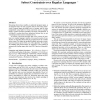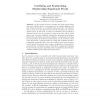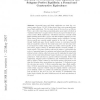25 search results - page 2 / 5 » Formal Correctness Proof for DPLL Procedure |
ECCC
2007
13 years 4 months ago
2007
Satisfiability algorithms have become one of the most practical and successful approaches for solving a variety of real-world problems, including hardware verification, experime...
LICS
2008
IEEE
13 years 11 months ago
2008
IEEE
LF is a dependent type theory in which many other formal systems can be conveniently embedded. However, correct use of LF relies on nontrivial metatheoretic developments such as p...
PLDI
2009
ACM
14 years 5 months ago
2009
ACM
Reasoning about string variables, in particular program inputs, is an important aspect of many program analyses and testing frameworks. Program inputs invariably arrive as strings...
FM
2003
Springer
13 years 10 months ago
2003
Springer
As the systems we have to specify and verify become larger and more complex, there is a mounting need to combine different tools and decision procedures to accomplish large proof ...
CORR
2007
Springer
13 years 4 months ago
2007
Springer
Abstract. Sequential game and Nash equilibrium are basic key concepts in game theory. In 1953, Kuhn showed that every sequential game has a Nash equilibrium. The two main steps of ...



